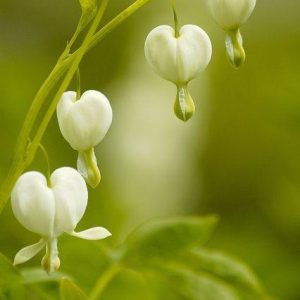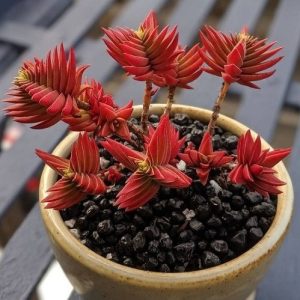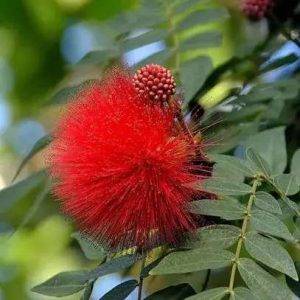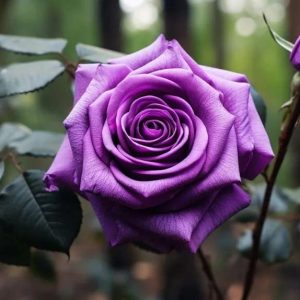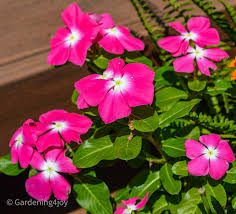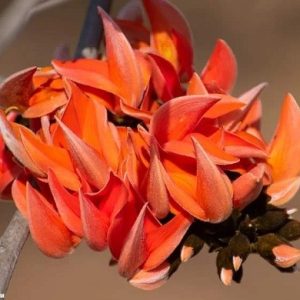Have you been thinking that your yard needs a pop of color? Maybe you’re looking for a statement piece to center your landscaping design. Red flowering shrubs can make a powerful statement in any landscape, and we’ve got 21 options with something for every growing zone.
Red is all about passion and power. Even the most delicate flower types can add pizzazz and enhance your curb appeal, but only if you select the right plants! Shrubs can flank a design, form a border, or create a colorful privacy hedge, and many require limited maintenance.
If you’re not ready to commit to a shrub, you could start with a few red flowers to see how well it mirrors your garden’s style. For those of you ready to take the leap, read on to learn about our favorite red flowering shrubs and how they can power up your yard or garden space.

The first entry on our list of red flower bushes is the Aphrodite sweetshrub, a popular option that thrives in most climates. It can grow up to six feet wide and tall with a rounded appearance. The large, rusty-red blooms last from summer through fall and make a stark contrast to the glossy, green leaves. Plus, the flowers smell heavenly.
Not only are these shrubs heat tolerant, but they are also deer resistant. Aphrodite sweetshrubs thrive in well-drained soil and can handle full sun to partial shade. It’s best to prune them after flowering and mulch the base to keep roots cool and comfortable.

Azaleas are technically a subspecies of Rhododendron, but they are so popular in gardens around the world that they earn a place on this list. You can find azaleas in many colors, but the red varieties offer some of the most impressive blooms you can cultivate.
These evergreen bushes make a gorgeous border because they thrive in full sun or partial shade. Keep them moist but not over-watered. Some varieties are particular about soil pH, so if you have challenging soil, like clay, you might need to work with it a bit. Full-grown azaleas can reach up to five feet high and spread up to six feet.

The third red flowering shrub on our list is a truly unique option that can set off your yard with pops of color. It makes an impressive hedge, but it’s so adaptable that you can prune it to function more like a tree or shape them into individual shrubs. The brush-like flowers bloom throughout the year in warmer climates.
No matter how you train your bottlebrush to grow, it will produce the most blooms and fruit in full sun. Make sure the soil drains well and use mulch and compost to keep the nutrients flowing. Established bottlebrushes stand up well to drought but can rot if exposed to excessive water.

Bougainvilleas might be the most versatile red flowering bushes on our list because they can also be a vine or tree depending on the variety. However, if you want a bloom-laden shrub that requires limited effort, this one is a show-stopper.
Though it looks like any other thorny evergreen during the winter and spring, a bougainvillea produces massive amounts of summer blooms. You can choose several colors, but the crimson varieties create brilliant red waves that make a statement in any landscape.
Aside from gorgeous blooms, you get a drought-resistant shrub that loves full sun and warm weather. Unlike the vine varieties, bougainvilleas shrubs are hardy and typically only require regular pruning.

The aptly named butterfly bush is likely to attract some winged friends to your yard. Butterfly bushes are easy to grow and care for. They are also versatile enough to thrive in pots or form a short border-hedge. They also smell incredible through the summer and fall. Though it’s traditionally known for lavender to pink flowers, some cultivators have created some shrubs with red blooms.
These shrubs love full sun and well-drained soil. They can grow up to five feet in every direction, though you can prune them to a size that works for your space.
It’s important to note that some varieties of butterfly bushes are listed as invasive in parts of the United States, so be wary when selecting one. Regular pruning during late winter is key to keeping these shrubs in check.

Gardeners in warm climates seeking an evergreen shrub with red flowers might want to try a distylium. Several varieties produce deep red to maroon flowers from January through March, providing some color when you need it most. The dainty flowers emerge along the stalks and look much like drops of red on the emerald foliage.
Distylium requires limited care and handles partial shade to full sun. They require limited pruning because of their compact nature. Distylium is pest-resistant, disease-resistant, and doesn’t appeal to critters looking for meals, including deer and rabbits.

This red flowering shrub is sometimes listed as a redclaw, but it’s commonly known as an escallonia. These fast-growing shrubs feature glossy leaves and delicate, sweet-smelling, tube-shaped flowers. They are easy to care for and maintain blooms for months.
Unchecked escallonias can grow up to fifteen feet in every direction, depending on the variety, so pruning is crucial. These shrubs love full sun but can handle partial shade in warmer climates. They prefer well-drained soil but require regular watering, preferably an irrigation system, in drought conditions.

Are you looking for a shrub that makes a statement but doesn’t require a lot of work? The flowering quince is a deciduous shrub that requires little maintenance but looks impressive. Since they can grow more than six feet in every direction, you can easily convert a few into a hedge or border. Also, established plants are rather hardy, even in cold temperatures.
Despite the spiky appearance, this shrub makes a stunning addition to any space with blooms that last from late winter through early spring. Plus, you can harvest its fruit to make jams!
The flowering quince does best in full sun because partial shade reduces the number of blooms and can impact fruit production. This shrub prefers loamy soil, but it can survive in clay or sand.

Hibiscus is another versatile plant that makes a stunning shrub with massive flowers that can be up to nine inches. Tropical varieties can thrive in warm climates with plenty of humidity and no concerns for cold temperatures.
Perennial shrubs are hardier options that grow well in most areas with full sun and plenty of water. They lose foliage during cold months and take a bit to regain mass in the spring, but fill out nicely each year. Like many shrubs on this list, red flowers aren’t your only option, but the hibiscus varieties have a wide range of hues from deep crimson to a jewel-toned ruby.
It’s important to hold back on pruning until spring so that the fallen foliage and bare branches can protect the shrub during winter. They can reach up to five feet tall and wide to create a sizable shrub or as part of a mixed hedge.

Hydrangeas were traditionally warm-weather shrubs that yielded stunning flower heads in various hues, but some cultivators created hardier versions to withstand colder climates. Though it’s easy to picture these bushes as purple or white, there are some red varieties ranging from pinkish-red to soft crimson hues.
Most hydrangeas prefer partial sun, preferably where they catch the morning rays but have protection from the midday heat. Depending on the variety, you can expect them to reach up to ten feet. Keep the soil moist but not soaking, and consider mulching around the base to keep moisture and nutrients near the roots.

Whether you need a small border or some accent shrubs, the red bush lantana makes a viable option. The foliage remains intact and evergreen in warm climates and then blooms delicate red flowers with pops of yellow throughout the year.
Red bush lantanas need warm, frost-free weather and full sun to thrive, so it’s not an option for everyone. It takes a few years to establish, but once it does, you can expect a colorful display. This shrub requires limited care and handles drought well. In many places, lantanas are considered perennials. In colder locations, they are planted as annuals that will bloom all summer.

If you live in a warmer climate and don’t mind unruly red flowering bushes, you might want to consider planting some pentas. These shrubs add texture and color to any landscape with spear-shaped leaves serving as a backdrop to mounds of delicate star-shaped flowers.
Though these shrubs can grow a little unruly, they don’t require much effort as long as they get plenty of sunshine and water. Pentas shrubs are disease-resistant, so the only real issue you might encounter is spider mites.

Proteas are large shrubs with blooms from late winter to spring that range from white or yellow to pinkish-red or red. There are many varieties thanks to years of cross-breeding the hardy shrub. Some gardeners successfully train certain varieties of proteas to grow tall and tree-like.
These shrubs thrive in full sun and love acidic soil. They prefer loamy or sandy soil in hot climates. Warning: proteas can be toxic to pets and people if ingested.

You can’t have a list of bushes that have red flowers without mentioning rhododendrons. There are more than 900 species to choose from, including the aforementioned azaleas. You can even find a variety for nearly every climate, including colder zones.
Rhododendron shrubs love growing under tree cover or in partial shade with moist, well-drained soil. Other than watering them regularly during drier periods, most rhododendrons don’t require much care. You don’t even have to prune them unless you need to remove dead or damaged stems.

Rose bushes, or shrub roses, remain a staple in many gardens. You have a selection of colors at your disposal, including a wide range of reds. Whether you choose a traditional red rose bush or a blended variation, the classic shrub is a star in any landscape. Create a hedge or use them as a standalone feature to anchor your design.
Depending on the type, roses like average moisture in well-drained soil and thrive in full sun. It’s best to prune them in the early spring to welcome blooms by summer.

Rose-of-Sharon is a subspecies of the hibiscus family that can either be a small tree or a spreading, flowering shrub. Blooms typically emerge by late spring and stand out against the green foliage throughout the summer. However, many varieties offer little to no color through fall and winter, so you might want to balance a Rose-of-Sharon with evergreen plants.
As a shrub, Rose-of-Sharon handles many soil types and moisture conditions, but it prefers full sun with some midday protection. Prune and shape as needed, but late winter and early spring will yield the best results for the following blooming season.

Sageleaf willow is a shrub that’s native to the northern United States and Canada. The deciduous shrub is an excellent choice for adding texture to a design because of the unique foliage and flowers.
These shrubs are one of the more unique ones available because the flowers are more like a cluster of red stamens trimmed in silver or yellow. The leaves can be green to white and give way to silver stalks that yield bursts of red that make gorgeous decorations.
This shrub thrives in full sun with moist soil. It’s best to prune early in the spring, but you can use the clippings as indoor decor.

Spireas are popular shrubs because they are low-maintenance and feature longer bloom cycles. They can be squat, spreading shrubs, or grow up to eight feet tall and almost as wide. Some variations handle heat better, while others are better for colder climates. There is an option for almost everyone. These deer-resistant shrubs also attract butterflies and bees.
Depending on the variety, you have several color options available. Additionally, spireas typically fall into two categories, spring-bloom or summer-bloom. They grow fast and thrive in full sun. Try to keep soil neutral to slightly acidic for best results and prune as needed.

The smoke bush is another versatile option on our list of red flowering bushes. It is commonly a deciduous shrub, but some gardeners train it into small trees. The shrub earned its name from the billowy, smoke-like flowers that add texture and color to any garden.
Of note, not all smoke bushes feature red flowers, though many have leaves that turn red in fall. However, a few hardy variations feature red flowers and darker foliage to create a striking look from spring through fall.
Smoke bushes can reach up to six feet in all directions, though you can easily prune them down to smaller sizes and maintain them with regular pruning. They thrive in full sun but aren’t particular about soil.

This shrub is native to Australia and one of the nation’s most recognizable flowers. The crimson blooms have mounds of slender petals that make a stark contrast to the ridged green foliage. These shrubs can reach up to ten feet in every direction if left unchecked.
Waratahs need partial shade and protection from the midday sun. They thrive in well-drained soil and prefer mulching around the base for weed and moisture control. The shrubs don’t require much care but take a few years to mature enough to flower.

Rounding out our list of bushes with red flowers is a classic ornamental species that are available in various hues, both leaves, and flowers. The weigela can also range in size, from just over a foot up to twelve feet. They mostly produce in spring, but you could see some reblooms through the summer and fall.
Weigelas love full sun, but some varieties can handle partial shade. They need protection from the midday rays in warmer climates. Prune any dead branches in the spring and shape as needed. Watch for insects and powdery mildew on the leaves.
Hopefully, this list of our favorite red flowering shrubs helped you decide on the best way to add pops of blazing color to your landscape. Red is a powerful color that blends well with most color schemes, while adding depth to a space. Of course, if red isn’t quite your color, you could try a flowering bush in blue, yellow, or pink. No matter what happens, adding some color to your garden is almost always a great idea!
